Evidenced-Based Research on Maggot Debridement Therapy
VerifiedAdded on 2023/04/21
|12
|3058
|119
AI Summary
This article provides an overview of the literature on evidenced-based research on maggot debridement therapy for wound healing. It discusses the use of live maggots to clean damaged tissues and promote faster healing. The article also explores the prevalence and causes of diabetic foot ulcers, as well as the complications and efficacy of maggot therapy in their treatment. The research review includes analysis of peer-reviewed articles and their findings on the effectiveness of maggot debridement therapy. The strengths and weaknesses of this therapy are also discussed.
Contribute Materials
Your contribution can guide someone’s learning journey. Share your
documents today.
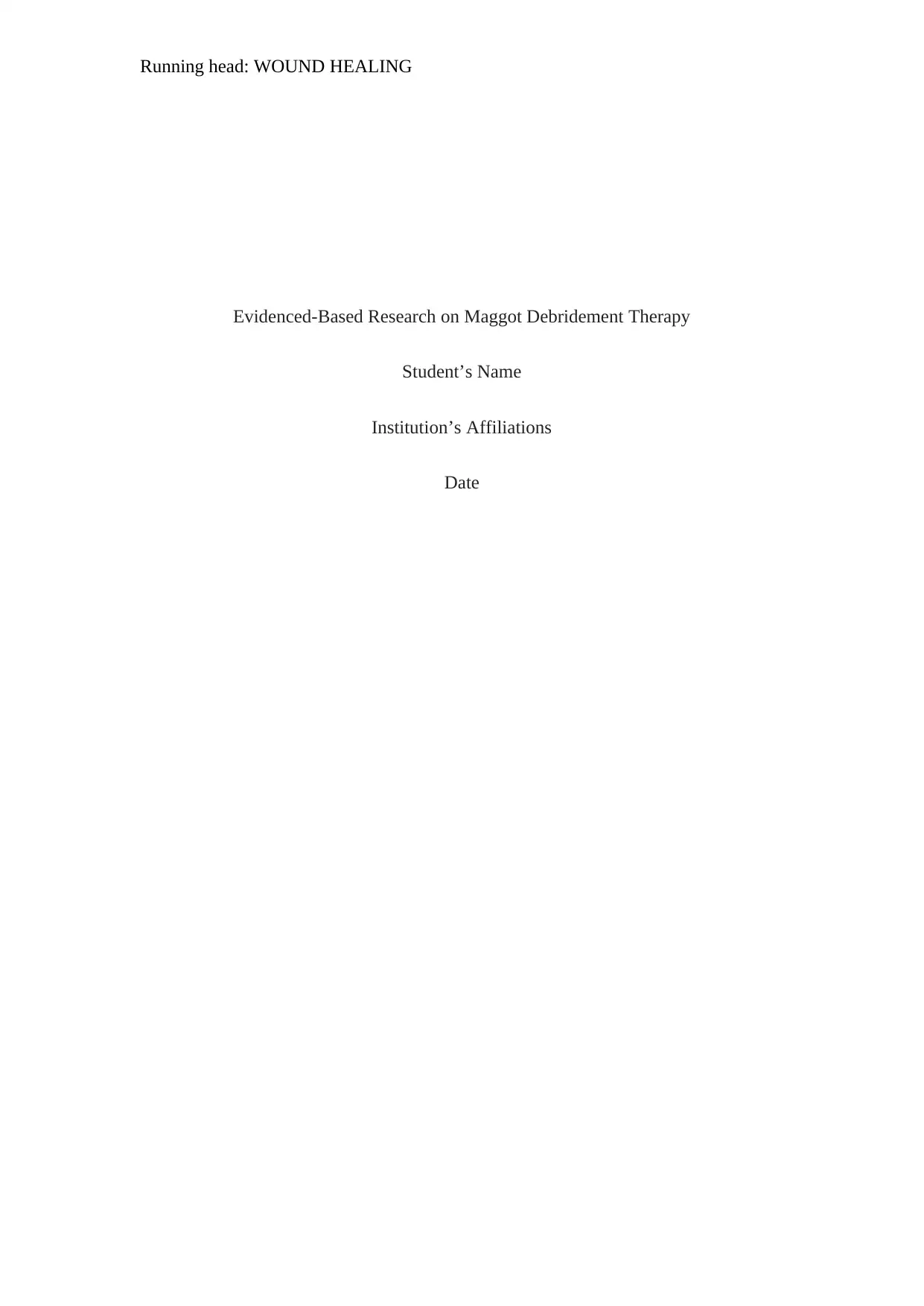
Running head: WOUND HEALING
Evidenced-Based Research on Maggot Debridement Therapy
Student’s Name
Institution’s Affiliations
Date
Evidenced-Based Research on Maggot Debridement Therapy
Student’s Name
Institution’s Affiliations
Date
Secure Best Marks with AI Grader
Need help grading? Try our AI Grader for instant feedback on your assignments.
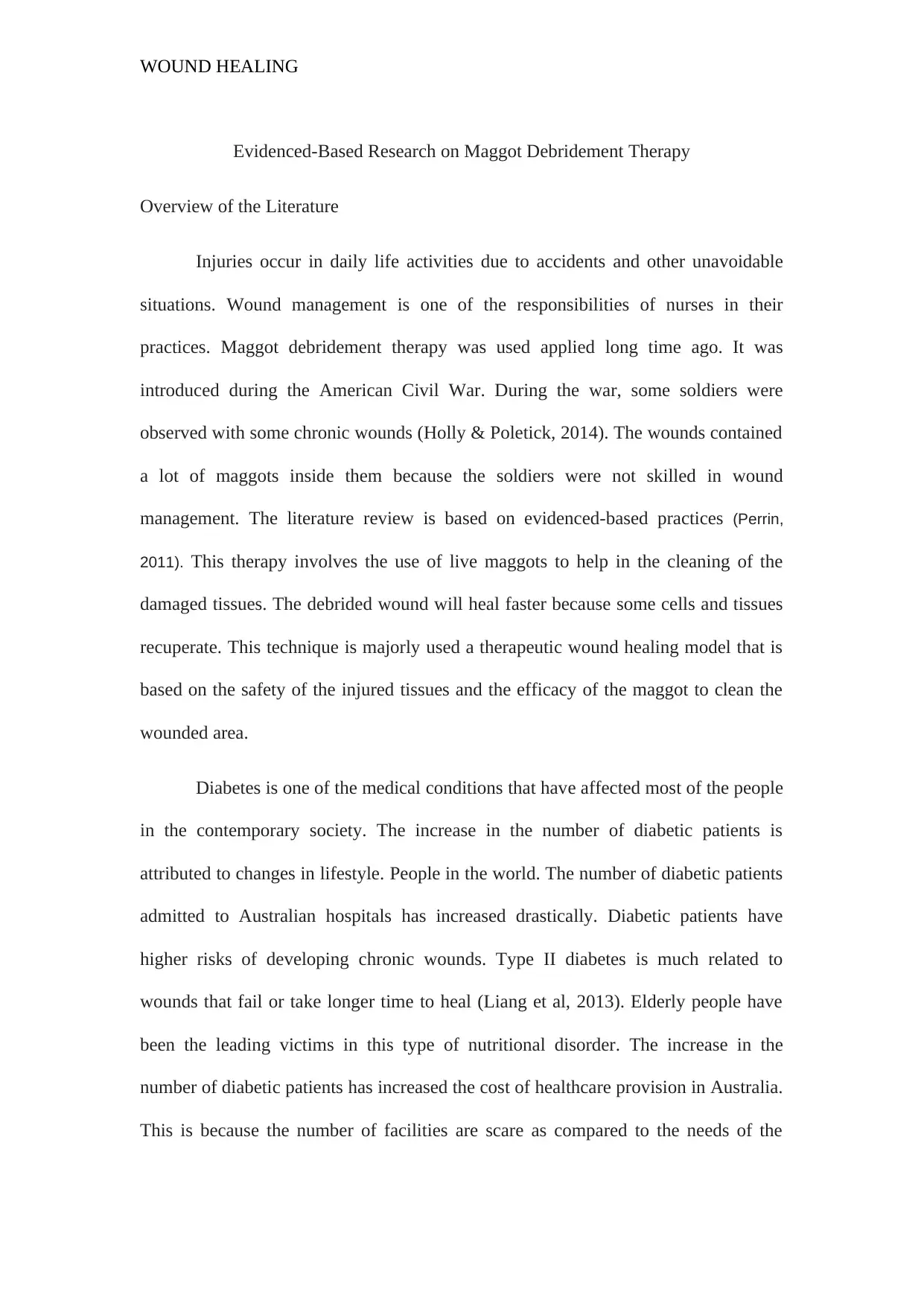
WOUND HEALING
Evidenced-Based Research on Maggot Debridement Therapy
Overview of the Literature
Injuries occur in daily life activities due to accidents and other unavoidable
situations. Wound management is one of the responsibilities of nurses in their
practices. Maggot debridement therapy was used applied long time ago. It was
introduced during the American Civil War. During the war, some soldiers were
observed with some chronic wounds (Holly & Poletick, 2014). The wounds contained
a lot of maggots inside them because the soldiers were not skilled in wound
management. The literature review is based on evidenced-based practices (Perrin,
2011). This therapy involves the use of live maggots to help in the cleaning of the
damaged tissues. The debrided wound will heal faster because some cells and tissues
recuperate. This technique is majorly used a therapeutic wound healing model that is
based on the safety of the injured tissues and the efficacy of the maggot to clean the
wounded area.
Diabetes is one of the medical conditions that have affected most of the people
in the contemporary society. The increase in the number of diabetic patients is
attributed to changes in lifestyle. People in the world. The number of diabetic patients
admitted to Australian hospitals has increased drastically. Diabetic patients have
higher risks of developing chronic wounds. Type II diabetes is much related to
wounds that fail or take longer time to heal (Liang et al, 2013). Elderly people have
been the leading victims in this type of nutritional disorder. The increase in the
number of diabetic patients has increased the cost of healthcare provision in Australia.
This is because the number of facilities are scare as compared to the needs of the
Evidenced-Based Research on Maggot Debridement Therapy
Overview of the Literature
Injuries occur in daily life activities due to accidents and other unavoidable
situations. Wound management is one of the responsibilities of nurses in their
practices. Maggot debridement therapy was used applied long time ago. It was
introduced during the American Civil War. During the war, some soldiers were
observed with some chronic wounds (Holly & Poletick, 2014). The wounds contained
a lot of maggots inside them because the soldiers were not skilled in wound
management. The literature review is based on evidenced-based practices (Perrin,
2011). This therapy involves the use of live maggots to help in the cleaning of the
damaged tissues. The debrided wound will heal faster because some cells and tissues
recuperate. This technique is majorly used a therapeutic wound healing model that is
based on the safety of the injured tissues and the efficacy of the maggot to clean the
wounded area.
Diabetes is one of the medical conditions that have affected most of the people
in the contemporary society. The increase in the number of diabetic patients is
attributed to changes in lifestyle. People in the world. The number of diabetic patients
admitted to Australian hospitals has increased drastically. Diabetic patients have
higher risks of developing chronic wounds. Type II diabetes is much related to
wounds that fail or take longer time to heal (Liang et al, 2013). Elderly people have
been the leading victims in this type of nutritional disorder. The increase in the
number of diabetic patients has increased the cost of healthcare provision in Australia.
This is because the number of facilities are scare as compared to the needs of the
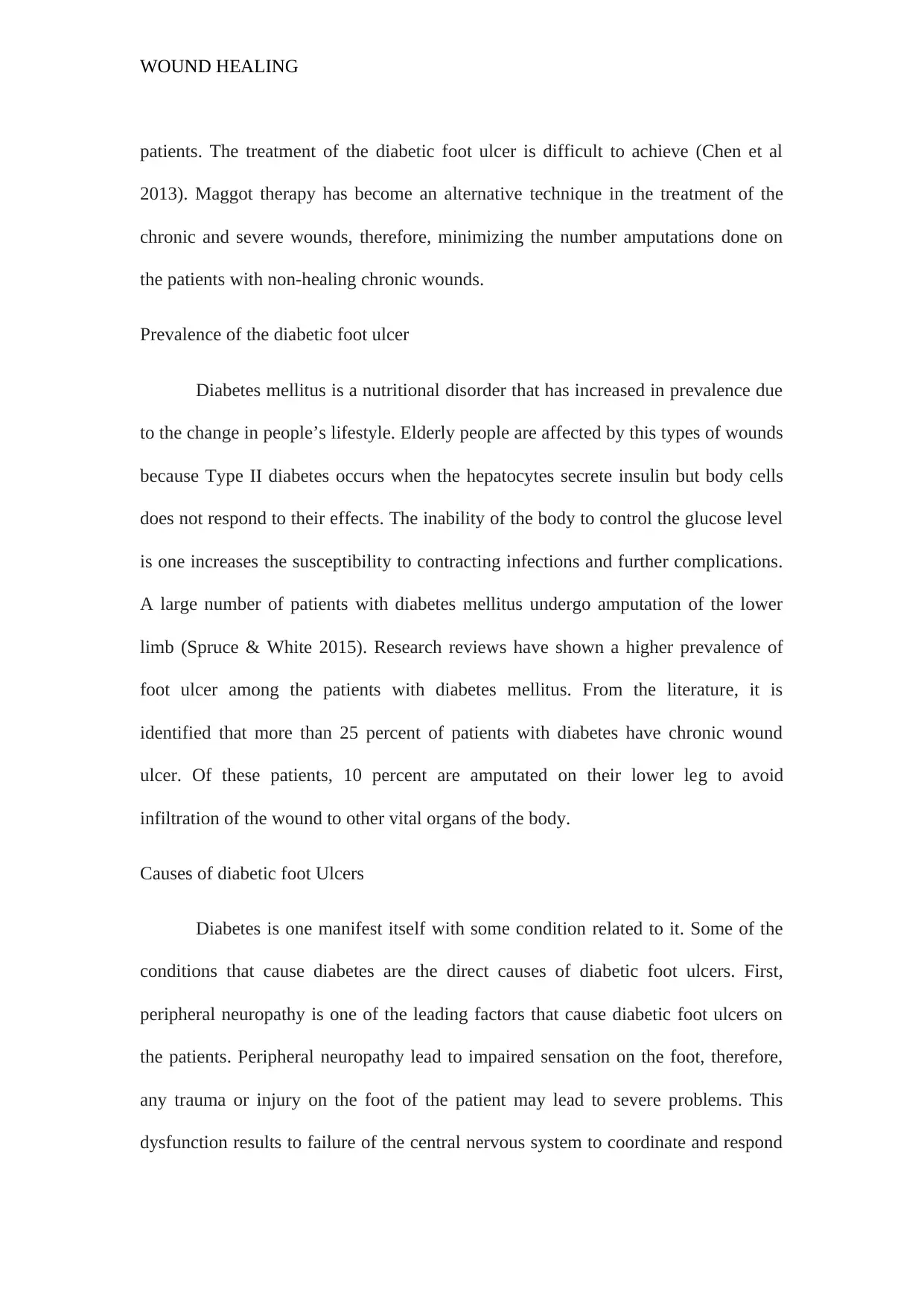
WOUND HEALING
patients. The treatment of the diabetic foot ulcer is difficult to achieve (Chen et al
2013). Maggot therapy has become an alternative technique in the treatment of the
chronic and severe wounds, therefore, minimizing the number amputations done on
the patients with non-healing chronic wounds.
Prevalence of the diabetic foot ulcer
Diabetes mellitus is a nutritional disorder that has increased in prevalence due
to the change in people’s lifestyle. Elderly people are affected by this types of wounds
because Type II diabetes occurs when the hepatocytes secrete insulin but body cells
does not respond to their effects. The inability of the body to control the glucose level
is one increases the susceptibility to contracting infections and further complications.
A large number of patients with diabetes mellitus undergo amputation of the lower
limb (Spruce & White 2015). Research reviews have shown a higher prevalence of
foot ulcer among the patients with diabetes mellitus. From the literature, it is
identified that more than 25 percent of patients with diabetes have chronic wound
ulcer. Of these patients, 10 percent are amputated on their lower leg to avoid
infiltration of the wound to other vital organs of the body.
Causes of diabetic foot Ulcers
Diabetes is one manifest itself with some condition related to it. Some of the
conditions that cause diabetes are the direct causes of diabetic foot ulcers. First,
peripheral neuropathy is one of the leading factors that cause diabetic foot ulcers on
the patients. Peripheral neuropathy lead to impaired sensation on the foot, therefore,
any trauma or injury on the foot of the patient may lead to severe problems. This
dysfunction results to failure of the central nervous system to coordinate and respond
patients. The treatment of the diabetic foot ulcer is difficult to achieve (Chen et al
2013). Maggot therapy has become an alternative technique in the treatment of the
chronic and severe wounds, therefore, minimizing the number amputations done on
the patients with non-healing chronic wounds.
Prevalence of the diabetic foot ulcer
Diabetes mellitus is a nutritional disorder that has increased in prevalence due
to the change in people’s lifestyle. Elderly people are affected by this types of wounds
because Type II diabetes occurs when the hepatocytes secrete insulin but body cells
does not respond to their effects. The inability of the body to control the glucose level
is one increases the susceptibility to contracting infections and further complications.
A large number of patients with diabetes mellitus undergo amputation of the lower
limb (Spruce & White 2015). Research reviews have shown a higher prevalence of
foot ulcer among the patients with diabetes mellitus. From the literature, it is
identified that more than 25 percent of patients with diabetes have chronic wound
ulcer. Of these patients, 10 percent are amputated on their lower leg to avoid
infiltration of the wound to other vital organs of the body.
Causes of diabetic foot Ulcers
Diabetes is one manifest itself with some condition related to it. Some of the
conditions that cause diabetes are the direct causes of diabetic foot ulcers. First,
peripheral neuropathy is one of the leading factors that cause diabetic foot ulcers on
the patients. Peripheral neuropathy lead to impaired sensation on the foot, therefore,
any trauma or injury on the foot of the patient may lead to severe problems. This
dysfunction results to failure of the central nervous system to coordinate and respond
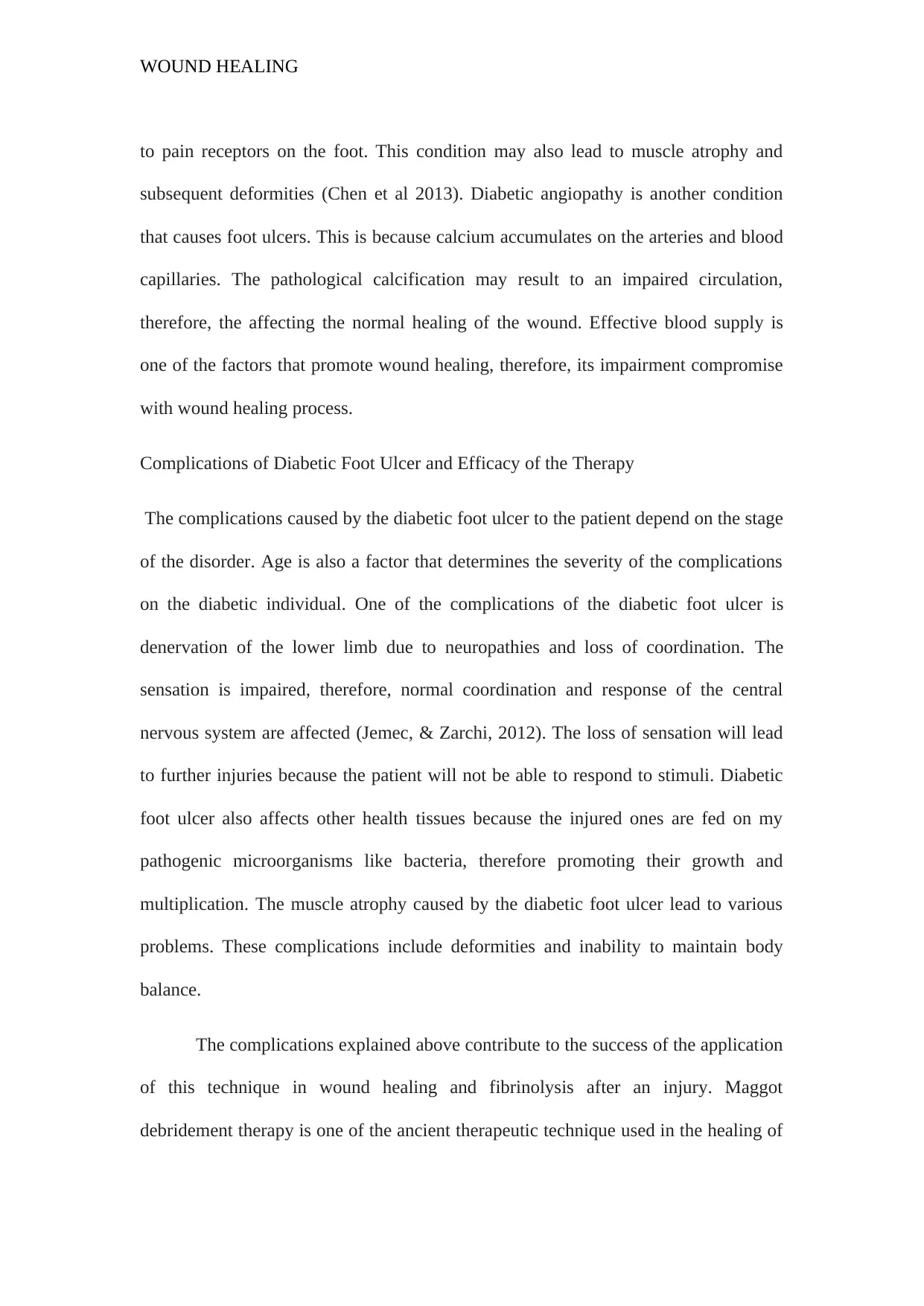
WOUND HEALING
to pain receptors on the foot. This condition may also lead to muscle atrophy and
subsequent deformities (Chen et al 2013). Diabetic angiopathy is another condition
that causes foot ulcers. This is because calcium accumulates on the arteries and blood
capillaries. The pathological calcification may result to an impaired circulation,
therefore, the affecting the normal healing of the wound. Effective blood supply is
one of the factors that promote wound healing, therefore, its impairment compromise
with wound healing process.
Complications of Diabetic Foot Ulcer and Efficacy of the Therapy
The complications caused by the diabetic foot ulcer to the patient depend on the stage
of the disorder. Age is also a factor that determines the severity of the complications
on the diabetic individual. One of the complications of the diabetic foot ulcer is
denervation of the lower limb due to neuropathies and loss of coordination. The
sensation is impaired, therefore, normal coordination and response of the central
nervous system are affected (Jemec, & Zarchi, 2012). The loss of sensation will lead
to further injuries because the patient will not be able to respond to stimuli. Diabetic
foot ulcer also affects other health tissues because the injured ones are fed on my
pathogenic microorganisms like bacteria, therefore promoting their growth and
multiplication. The muscle atrophy caused by the diabetic foot ulcer lead to various
problems. These complications include deformities and inability to maintain body
balance.
The complications explained above contribute to the success of the application
of this technique in wound healing and fibrinolysis after an injury. Maggot
debridement therapy is one of the ancient therapeutic technique used in the healing of
to pain receptors on the foot. This condition may also lead to muscle atrophy and
subsequent deformities (Chen et al 2013). Diabetic angiopathy is another condition
that causes foot ulcers. This is because calcium accumulates on the arteries and blood
capillaries. The pathological calcification may result to an impaired circulation,
therefore, the affecting the normal healing of the wound. Effective blood supply is
one of the factors that promote wound healing, therefore, its impairment compromise
with wound healing process.
Complications of Diabetic Foot Ulcer and Efficacy of the Therapy
The complications caused by the diabetic foot ulcer to the patient depend on the stage
of the disorder. Age is also a factor that determines the severity of the complications
on the diabetic individual. One of the complications of the diabetic foot ulcer is
denervation of the lower limb due to neuropathies and loss of coordination. The
sensation is impaired, therefore, normal coordination and response of the central
nervous system are affected (Jemec, & Zarchi, 2012). The loss of sensation will lead
to further injuries because the patient will not be able to respond to stimuli. Diabetic
foot ulcer also affects other health tissues because the injured ones are fed on my
pathogenic microorganisms like bacteria, therefore promoting their growth and
multiplication. The muscle atrophy caused by the diabetic foot ulcer lead to various
problems. These complications include deformities and inability to maintain body
balance.
The complications explained above contribute to the success of the application
of this technique in wound healing and fibrinolysis after an injury. Maggot
debridement therapy is one of the ancient therapeutic technique used in the healing of
Secure Best Marks with AI Grader
Need help grading? Try our AI Grader for instant feedback on your assignments.
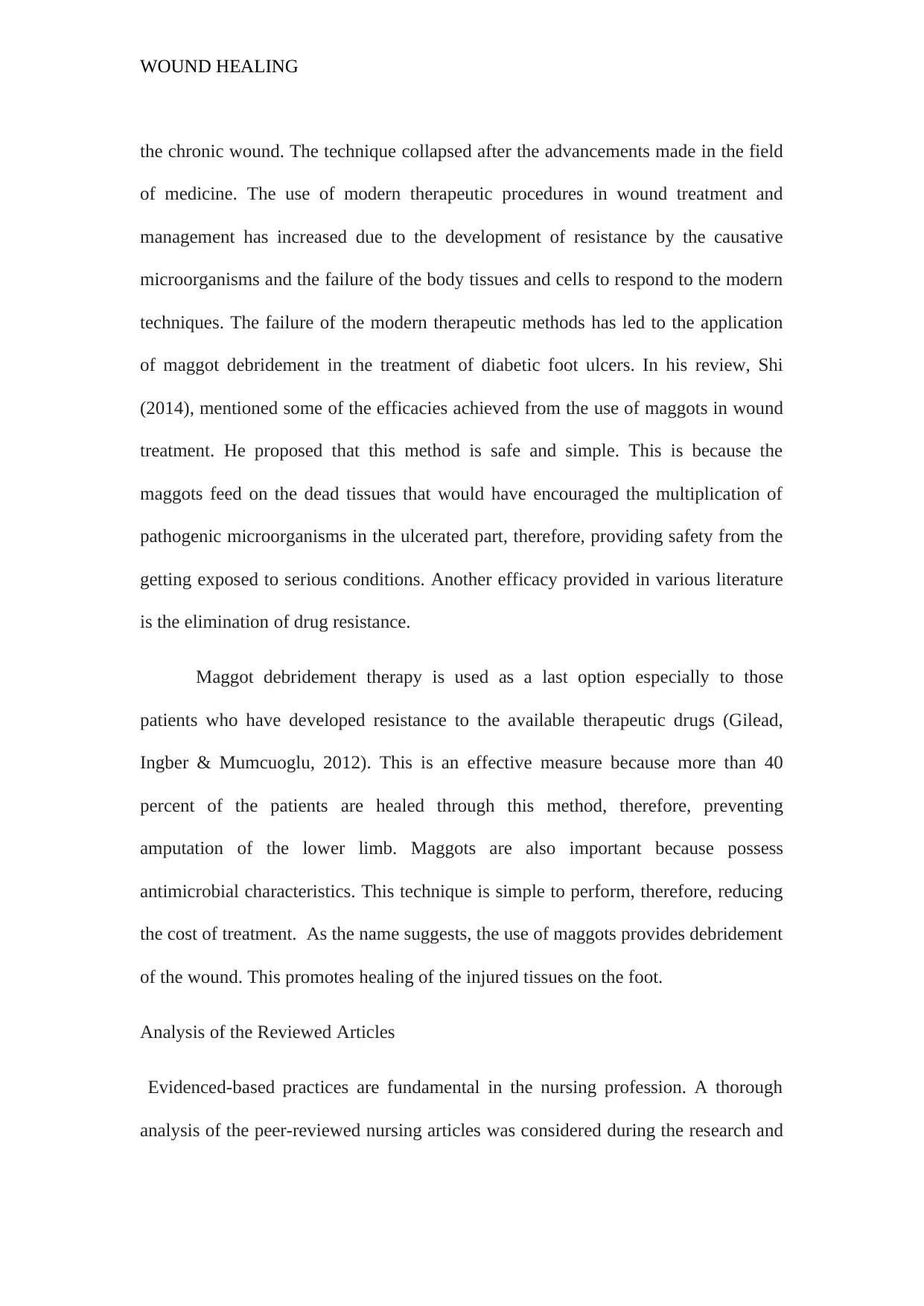
WOUND HEALING
the chronic wound. The technique collapsed after the advancements made in the field
of medicine. The use of modern therapeutic procedures in wound treatment and
management has increased due to the development of resistance by the causative
microorganisms and the failure of the body tissues and cells to respond to the modern
techniques. The failure of the modern therapeutic methods has led to the application
of maggot debridement in the treatment of diabetic foot ulcers. In his review, Shi
(2014), mentioned some of the efficacies achieved from the use of maggots in wound
treatment. He proposed that this method is safe and simple. This is because the
maggots feed on the dead tissues that would have encouraged the multiplication of
pathogenic microorganisms in the ulcerated part, therefore, providing safety from the
getting exposed to serious conditions. Another efficacy provided in various literature
is the elimination of drug resistance.
Maggot debridement therapy is used as a last option especially to those
patients who have developed resistance to the available therapeutic drugs (Gilead,
Ingber & Mumcuoglu, 2012). This is an effective measure because more than 40
percent of the patients are healed through this method, therefore, preventing
amputation of the lower limb. Maggots are also important because possess
antimicrobial characteristics. This technique is simple to perform, therefore, reducing
the cost of treatment. As the name suggests, the use of maggots provides debridement
of the wound. This promotes healing of the injured tissues on the foot.
Analysis of the Reviewed Articles
Evidenced-based practices are fundamental in the nursing profession. A thorough
analysis of the peer-reviewed nursing articles was considered during the research and
the chronic wound. The technique collapsed after the advancements made in the field
of medicine. The use of modern therapeutic procedures in wound treatment and
management has increased due to the development of resistance by the causative
microorganisms and the failure of the body tissues and cells to respond to the modern
techniques. The failure of the modern therapeutic methods has led to the application
of maggot debridement in the treatment of diabetic foot ulcers. In his review, Shi
(2014), mentioned some of the efficacies achieved from the use of maggots in wound
treatment. He proposed that this method is safe and simple. This is because the
maggots feed on the dead tissues that would have encouraged the multiplication of
pathogenic microorganisms in the ulcerated part, therefore, providing safety from the
getting exposed to serious conditions. Another efficacy provided in various literature
is the elimination of drug resistance.
Maggot debridement therapy is used as a last option especially to those
patients who have developed resistance to the available therapeutic drugs (Gilead,
Ingber & Mumcuoglu, 2012). This is an effective measure because more than 40
percent of the patients are healed through this method, therefore, preventing
amputation of the lower limb. Maggots are also important because possess
antimicrobial characteristics. This technique is simple to perform, therefore, reducing
the cost of treatment. As the name suggests, the use of maggots provides debridement
of the wound. This promotes healing of the injured tissues on the foot.
Analysis of the Reviewed Articles
Evidenced-based practices are fundamental in the nursing profession. A thorough
analysis of the peer-reviewed nursing articles was considered during the research and
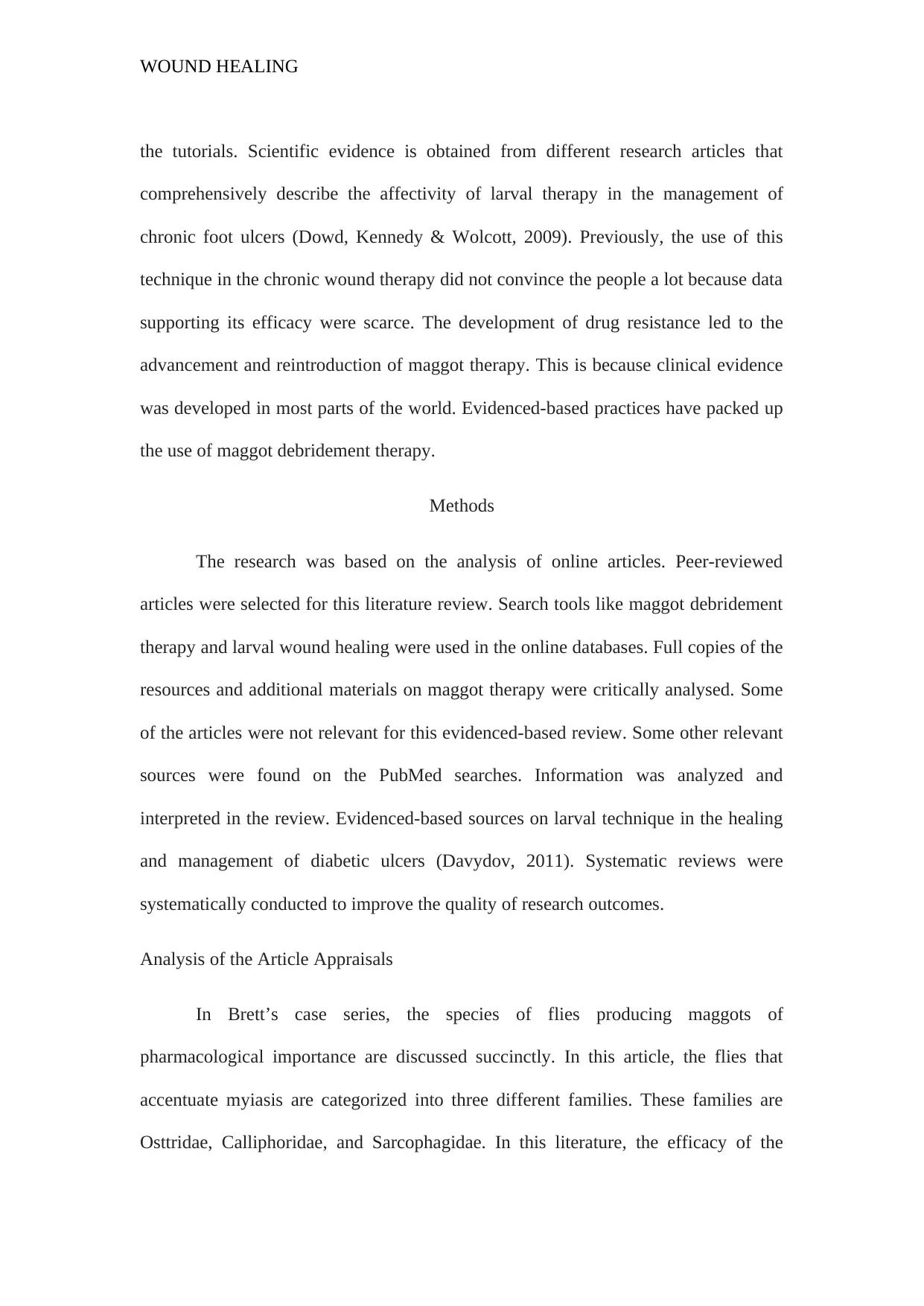
WOUND HEALING
the tutorials. Scientific evidence is obtained from different research articles that
comprehensively describe the affectivity of larval therapy in the management of
chronic foot ulcers (Dowd, Kennedy & Wolcott, 2009). Previously, the use of this
technique in the chronic wound therapy did not convince the people a lot because data
supporting its efficacy were scarce. The development of drug resistance led to the
advancement and reintroduction of maggot therapy. This is because clinical evidence
was developed in most parts of the world. Evidenced-based practices have packed up
the use of maggot debridement therapy.
Methods
The research was based on the analysis of online articles. Peer-reviewed
articles were selected for this literature review. Search tools like maggot debridement
therapy and larval wound healing were used in the online databases. Full copies of the
resources and additional materials on maggot therapy were critically analysed. Some
of the articles were not relevant for this evidenced-based review. Some other relevant
sources were found on the PubMed searches. Information was analyzed and
interpreted in the review. Evidenced-based sources on larval technique in the healing
and management of diabetic ulcers (Davydov, 2011). Systematic reviews were
systematically conducted to improve the quality of research outcomes.
Analysis of the Article Appraisals
In Brett’s case series, the species of flies producing maggots of
pharmacological importance are discussed succinctly. In this article, the flies that
accentuate myiasis are categorized into three different families. These families are
Osttridae, Calliphoridae, and Sarcophagidae. In this literature, the efficacy of the
the tutorials. Scientific evidence is obtained from different research articles that
comprehensively describe the affectivity of larval therapy in the management of
chronic foot ulcers (Dowd, Kennedy & Wolcott, 2009). Previously, the use of this
technique in the chronic wound therapy did not convince the people a lot because data
supporting its efficacy were scarce. The development of drug resistance led to the
advancement and reintroduction of maggot therapy. This is because clinical evidence
was developed in most parts of the world. Evidenced-based practices have packed up
the use of maggot debridement therapy.
Methods
The research was based on the analysis of online articles. Peer-reviewed
articles were selected for this literature review. Search tools like maggot debridement
therapy and larval wound healing were used in the online databases. Full copies of the
resources and additional materials on maggot therapy were critically analysed. Some
of the articles were not relevant for this evidenced-based review. Some other relevant
sources were found on the PubMed searches. Information was analyzed and
interpreted in the review. Evidenced-based sources on larval technique in the healing
and management of diabetic ulcers (Davydov, 2011). Systematic reviews were
systematically conducted to improve the quality of research outcomes.
Analysis of the Article Appraisals
In Brett’s case series, the species of flies producing maggots of
pharmacological importance are discussed succinctly. In this article, the flies that
accentuate myiasis are categorized into three different families. These families are
Osttridae, Calliphoridae, and Sarcophagidae. In this literature, the efficacy of the
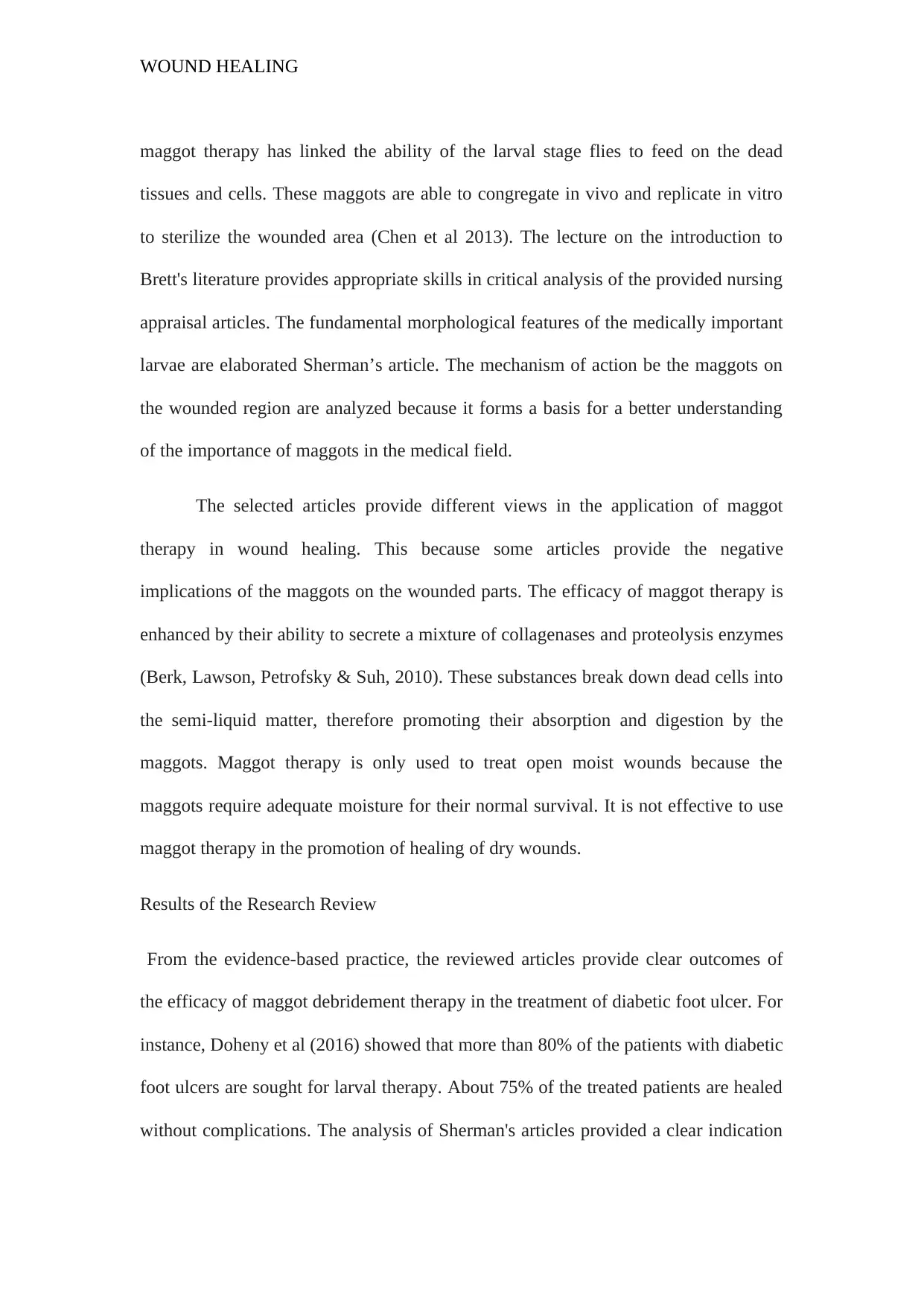
WOUND HEALING
maggot therapy has linked the ability of the larval stage flies to feed on the dead
tissues and cells. These maggots are able to congregate in vivo and replicate in vitro
to sterilize the wounded area (Chen et al 2013). The lecture on the introduction to
Brett's literature provides appropriate skills in critical analysis of the provided nursing
appraisal articles. The fundamental morphological features of the medically important
larvae are elaborated Sherman’s article. The mechanism of action be the maggots on
the wounded region are analyzed because it forms a basis for a better understanding
of the importance of maggots in the medical field.
The selected articles provide different views in the application of maggot
therapy in wound healing. This because some articles provide the negative
implications of the maggots on the wounded parts. The efficacy of maggot therapy is
enhanced by their ability to secrete a mixture of collagenases and proteolysis enzymes
(Berk, Lawson, Petrofsky & Suh, 2010). These substances break down dead cells into
the semi-liquid matter, therefore promoting their absorption and digestion by the
maggots. Maggot therapy is only used to treat open moist wounds because the
maggots require adequate moisture for their normal survival. It is not effective to use
maggot therapy in the promotion of healing of dry wounds.
Results of the Research Review
From the evidence-based practice, the reviewed articles provide clear outcomes of
the efficacy of maggot debridement therapy in the treatment of diabetic foot ulcer. For
instance, Doheny et al (2016) showed that more than 80% of the patients with diabetic
foot ulcers are sought for larval therapy. About 75% of the treated patients are healed
without complications. The analysis of Sherman's articles provided a clear indication
maggot therapy has linked the ability of the larval stage flies to feed on the dead
tissues and cells. These maggots are able to congregate in vivo and replicate in vitro
to sterilize the wounded area (Chen et al 2013). The lecture on the introduction to
Brett's literature provides appropriate skills in critical analysis of the provided nursing
appraisal articles. The fundamental morphological features of the medically important
larvae are elaborated Sherman’s article. The mechanism of action be the maggots on
the wounded region are analyzed because it forms a basis for a better understanding
of the importance of maggots in the medical field.
The selected articles provide different views in the application of maggot
therapy in wound healing. This because some articles provide the negative
implications of the maggots on the wounded parts. The efficacy of maggot therapy is
enhanced by their ability to secrete a mixture of collagenases and proteolysis enzymes
(Berk, Lawson, Petrofsky & Suh, 2010). These substances break down dead cells into
the semi-liquid matter, therefore promoting their absorption and digestion by the
maggots. Maggot therapy is only used to treat open moist wounds because the
maggots require adequate moisture for their normal survival. It is not effective to use
maggot therapy in the promotion of healing of dry wounds.
Results of the Research Review
From the evidence-based practice, the reviewed articles provide clear outcomes of
the efficacy of maggot debridement therapy in the treatment of diabetic foot ulcer. For
instance, Doheny et al (2016) showed that more than 80% of the patients with diabetic
foot ulcers are sought for larval therapy. About 75% of the treated patients are healed
without complications. The analysis of Sherman's articles provided a clear indication
Paraphrase This Document
Need a fresh take? Get an instant paraphrase of this document with our AI Paraphraser
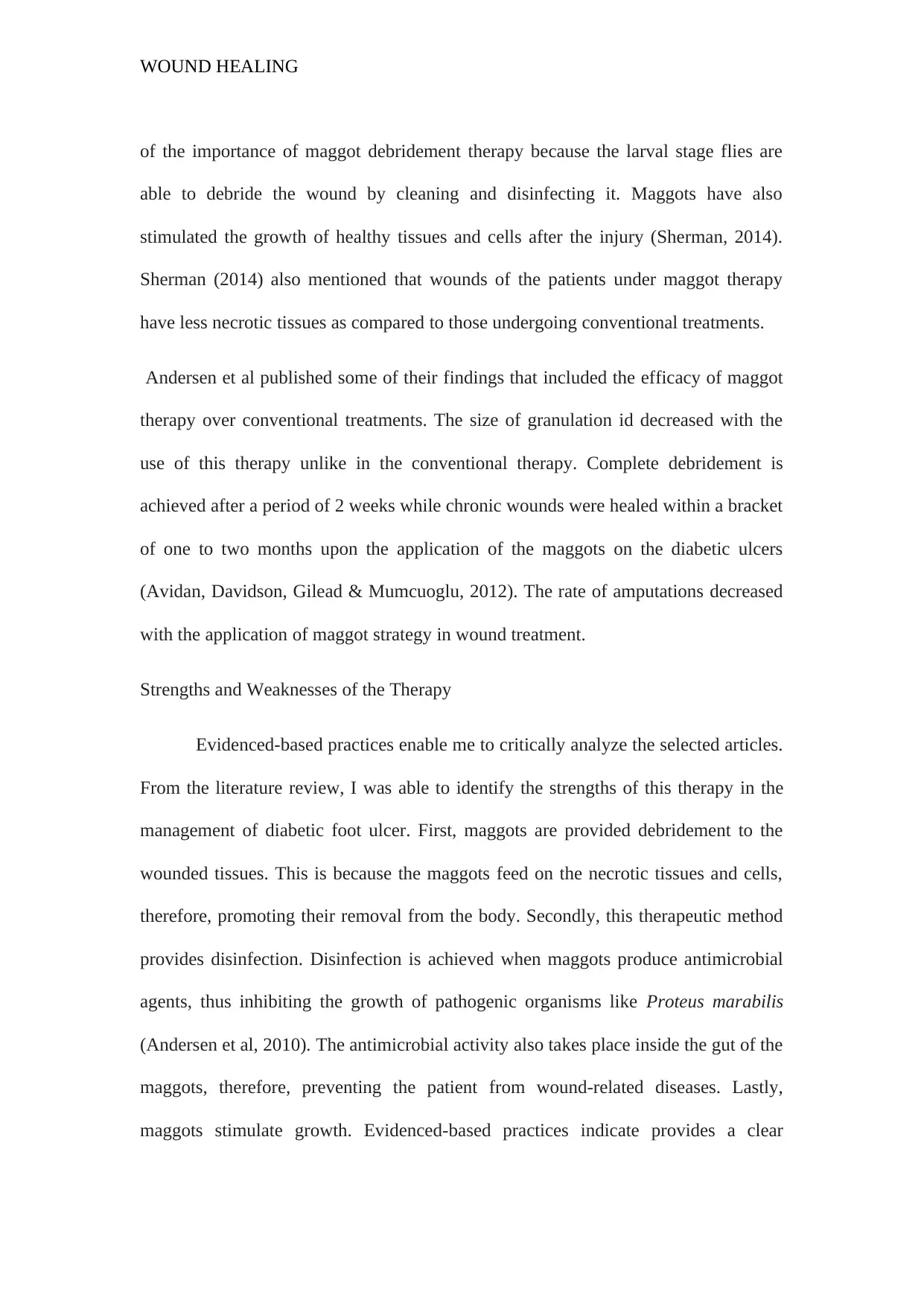
WOUND HEALING
of the importance of maggot debridement therapy because the larval stage flies are
able to debride the wound by cleaning and disinfecting it. Maggots have also
stimulated the growth of healthy tissues and cells after the injury (Sherman, 2014).
Sherman (2014) also mentioned that wounds of the patients under maggot therapy
have less necrotic tissues as compared to those undergoing conventional treatments.
Andersen et al published some of their findings that included the efficacy of maggot
therapy over conventional treatments. The size of granulation id decreased with the
use of this therapy unlike in the conventional therapy. Complete debridement is
achieved after a period of 2 weeks while chronic wounds were healed within a bracket
of one to two months upon the application of the maggots on the diabetic ulcers
(Avidan, Davidson, Gilead & Mumcuoglu, 2012). The rate of amputations decreased
with the application of maggot strategy in wound treatment.
Strengths and Weaknesses of the Therapy
Evidenced-based practices enable me to critically analyze the selected articles.
From the literature review, I was able to identify the strengths of this therapy in the
management of diabetic foot ulcer. First, maggots are provided debridement to the
wounded tissues. This is because the maggots feed on the necrotic tissues and cells,
therefore, promoting their removal from the body. Secondly, this therapeutic method
provides disinfection. Disinfection is achieved when maggots produce antimicrobial
agents, thus inhibiting the growth of pathogenic organisms like Proteus marabilis
(Andersen et al, 2010). The antimicrobial activity also takes place inside the gut of the
maggots, therefore, preventing the patient from wound-related diseases. Lastly,
maggots stimulate growth. Evidenced-based practices indicate provides a clear
of the importance of maggot debridement therapy because the larval stage flies are
able to debride the wound by cleaning and disinfecting it. Maggots have also
stimulated the growth of healthy tissues and cells after the injury (Sherman, 2014).
Sherman (2014) also mentioned that wounds of the patients under maggot therapy
have less necrotic tissues as compared to those undergoing conventional treatments.
Andersen et al published some of their findings that included the efficacy of maggot
therapy over conventional treatments. The size of granulation id decreased with the
use of this therapy unlike in the conventional therapy. Complete debridement is
achieved after a period of 2 weeks while chronic wounds were healed within a bracket
of one to two months upon the application of the maggots on the diabetic ulcers
(Avidan, Davidson, Gilead & Mumcuoglu, 2012). The rate of amputations decreased
with the application of maggot strategy in wound treatment.
Strengths and Weaknesses of the Therapy
Evidenced-based practices enable me to critically analyze the selected articles.
From the literature review, I was able to identify the strengths of this therapy in the
management of diabetic foot ulcer. First, maggots are provided debridement to the
wounded tissues. This is because the maggots feed on the necrotic tissues and cells,
therefore, promoting their removal from the body. Secondly, this therapeutic method
provides disinfection. Disinfection is achieved when maggots produce antimicrobial
agents, thus inhibiting the growth of pathogenic organisms like Proteus marabilis
(Andersen et al, 2010). The antimicrobial activity also takes place inside the gut of the
maggots, therefore, preventing the patient from wound-related diseases. Lastly,
maggots stimulate growth. Evidenced-based practices indicate provides a clear
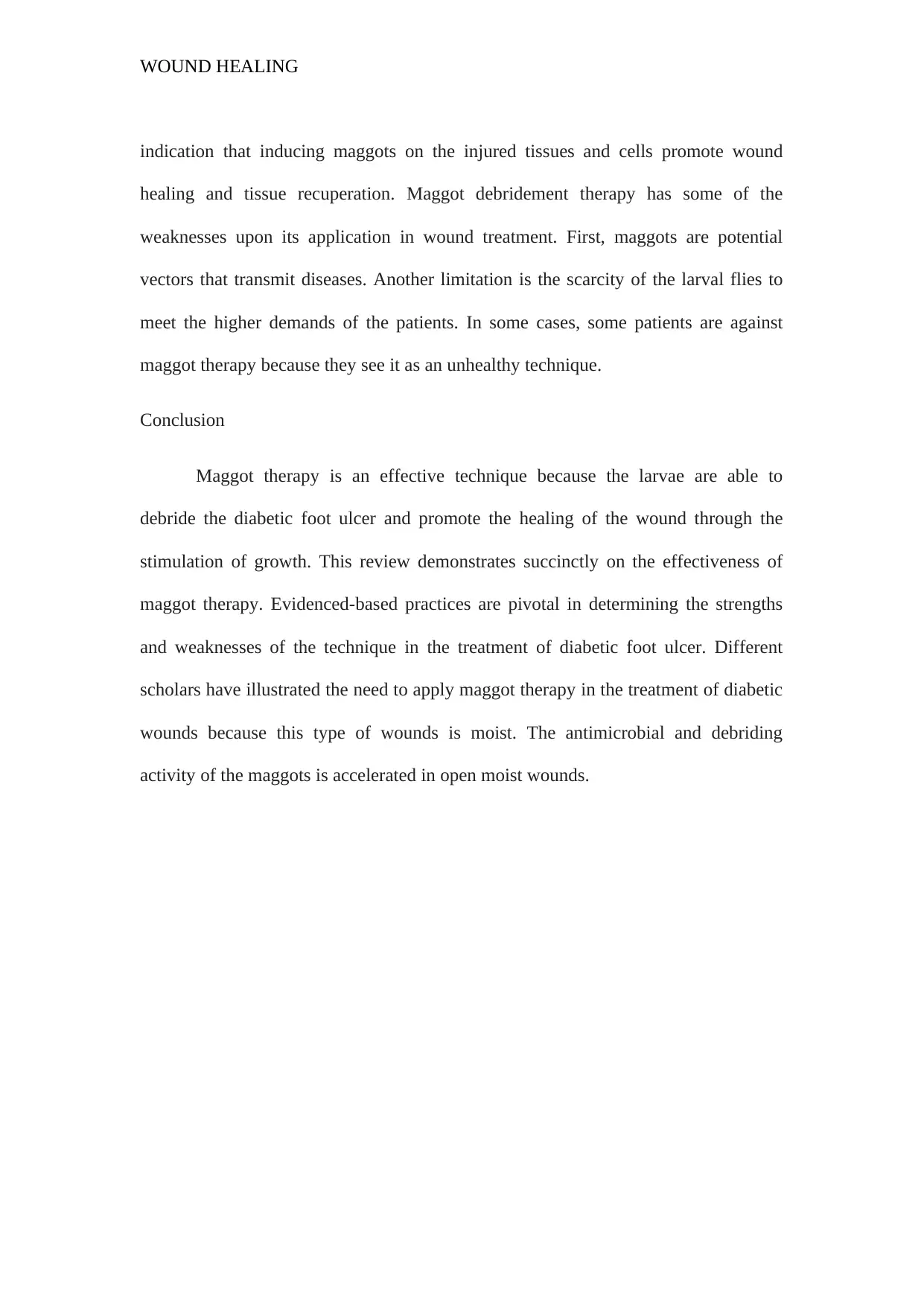
WOUND HEALING
indication that inducing maggots on the injured tissues and cells promote wound
healing and tissue recuperation. Maggot debridement therapy has some of the
weaknesses upon its application in wound treatment. First, maggots are potential
vectors that transmit diseases. Another limitation is the scarcity of the larval flies to
meet the higher demands of the patients. In some cases, some patients are against
maggot therapy because they see it as an unhealthy technique.
Conclusion
Maggot therapy is an effective technique because the larvae are able to
debride the diabetic foot ulcer and promote the healing of the wound through the
stimulation of growth. This review demonstrates succinctly on the effectiveness of
maggot therapy. Evidenced-based practices are pivotal in determining the strengths
and weaknesses of the technique in the treatment of diabetic foot ulcer. Different
scholars have illustrated the need to apply maggot therapy in the treatment of diabetic
wounds because this type of wounds is moist. The antimicrobial and debriding
activity of the maggots is accelerated in open moist wounds.
indication that inducing maggots on the injured tissues and cells promote wound
healing and tissue recuperation. Maggot debridement therapy has some of the
weaknesses upon its application in wound treatment. First, maggots are potential
vectors that transmit diseases. Another limitation is the scarcity of the larval flies to
meet the higher demands of the patients. In some cases, some patients are against
maggot therapy because they see it as an unhealthy technique.
Conclusion
Maggot therapy is an effective technique because the larvae are able to
debride the diabetic foot ulcer and promote the healing of the wound through the
stimulation of growth. This review demonstrates succinctly on the effectiveness of
maggot therapy. Evidenced-based practices are pivotal in determining the strengths
and weaknesses of the technique in the treatment of diabetic foot ulcer. Different
scholars have illustrated the need to apply maggot therapy in the treatment of diabetic
wounds because this type of wounds is moist. The antimicrobial and debriding
activity of the maggots is accelerated in open moist wounds.
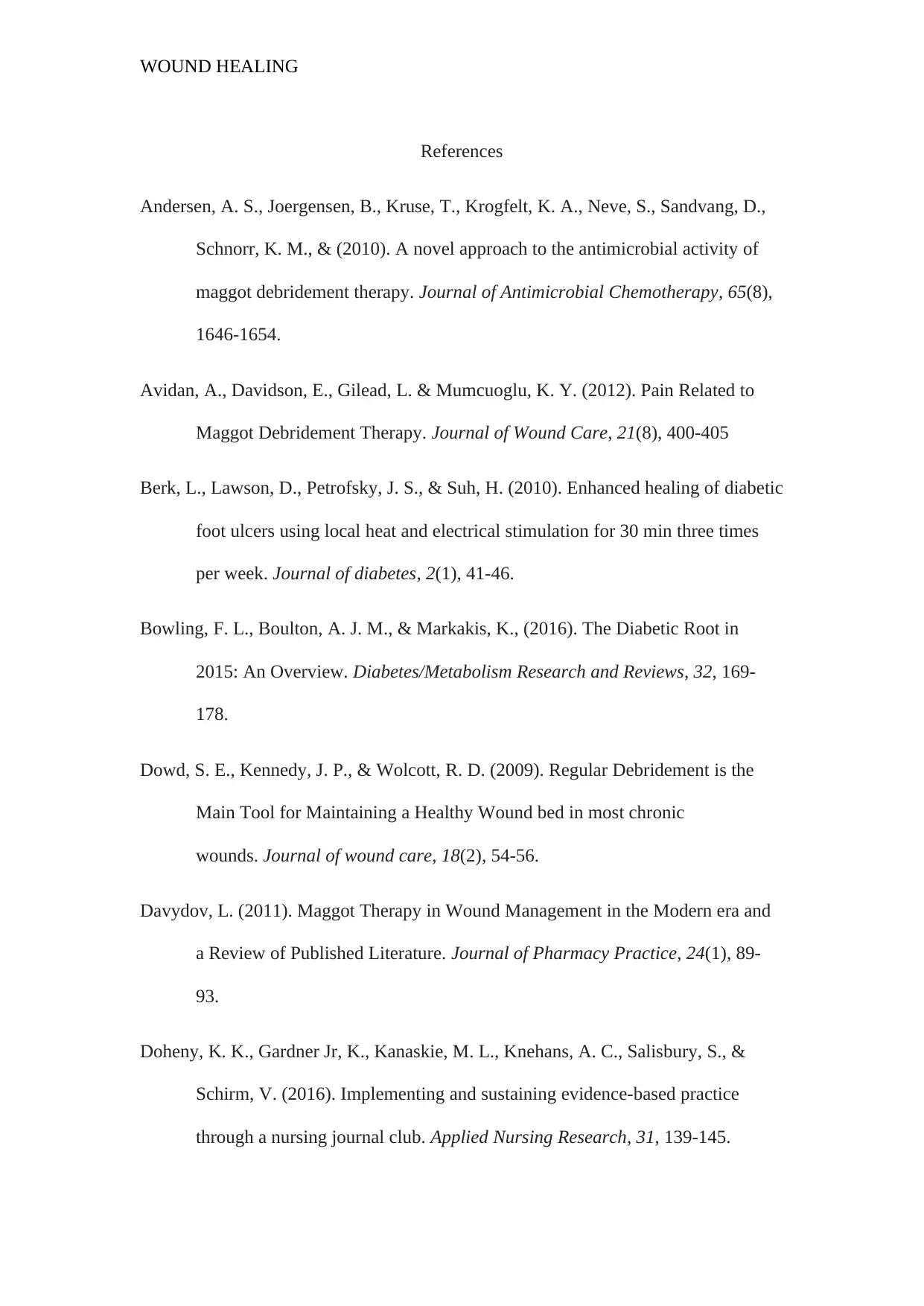
WOUND HEALING
References
Andersen, A. S., Joergensen, B., Kruse, T., Krogfelt, K. A., Neve, S., Sandvang, D.,
Schnorr, K. M., & (2010). A novel approach to the antimicrobial activity of
maggot debridement therapy. Journal of Antimicrobial Chemotherapy, 65(8),
1646-1654.
Avidan, A., Davidson, E., Gilead, L. & Mumcuoglu, K. Y. (2012). Pain Related to
Maggot Debridement Therapy. Journal of Wound Care, 21(8), 400-405
Berk, L., Lawson, D., Petrofsky, J. S., & Suh, H. (2010). Enhanced healing of diabetic
foot ulcers using local heat and electrical stimulation for 30 min three times
per week. Journal of diabetes, 2(1), 41-46.
Bowling, F. L., Boulton, A. J. M., & Markakis, K., (2016). The Diabetic Root in
2015: An Overview. Diabetes/Metabolism Research and Reviews, 32, 169-
178.
Dowd, S. E., Kennedy, J. P., & Wolcott, R. D. (2009). Regular Debridement is the
Main Tool for Maintaining a Healthy Wound bed in most chronic
wounds. Journal of wound care, 18(2), 54-56.
Davydov, L. (2011). Maggot Therapy in Wound Management in the Modern era and
a Review of Published Literature. Journal of Pharmacy Practice, 24(1), 89-
93.
Doheny, K. K., Gardner Jr, K., Kanaskie, M. L., Knehans, A. C., Salisbury, S., &
Schirm, V. (2016). Implementing and sustaining evidence-based practice
through a nursing journal club. Applied Nursing Research, 31, 139-145.
References
Andersen, A. S., Joergensen, B., Kruse, T., Krogfelt, K. A., Neve, S., Sandvang, D.,
Schnorr, K. M., & (2010). A novel approach to the antimicrobial activity of
maggot debridement therapy. Journal of Antimicrobial Chemotherapy, 65(8),
1646-1654.
Avidan, A., Davidson, E., Gilead, L. & Mumcuoglu, K. Y. (2012). Pain Related to
Maggot Debridement Therapy. Journal of Wound Care, 21(8), 400-405
Berk, L., Lawson, D., Petrofsky, J. S., & Suh, H. (2010). Enhanced healing of diabetic
foot ulcers using local heat and electrical stimulation for 30 min three times
per week. Journal of diabetes, 2(1), 41-46.
Bowling, F. L., Boulton, A. J. M., & Markakis, K., (2016). The Diabetic Root in
2015: An Overview. Diabetes/Metabolism Research and Reviews, 32, 169-
178.
Dowd, S. E., Kennedy, J. P., & Wolcott, R. D. (2009). Regular Debridement is the
Main Tool for Maintaining a Healthy Wound bed in most chronic
wounds. Journal of wound care, 18(2), 54-56.
Davydov, L. (2011). Maggot Therapy in Wound Management in the Modern era and
a Review of Published Literature. Journal of Pharmacy Practice, 24(1), 89-
93.
Doheny, K. K., Gardner Jr, K., Kanaskie, M. L., Knehans, A. C., Salisbury, S., &
Schirm, V. (2016). Implementing and sustaining evidence-based practice
through a nursing journal club. Applied Nursing Research, 31, 139-145.
Secure Best Marks with AI Grader
Need help grading? Try our AI Grader for instant feedback on your assignments.
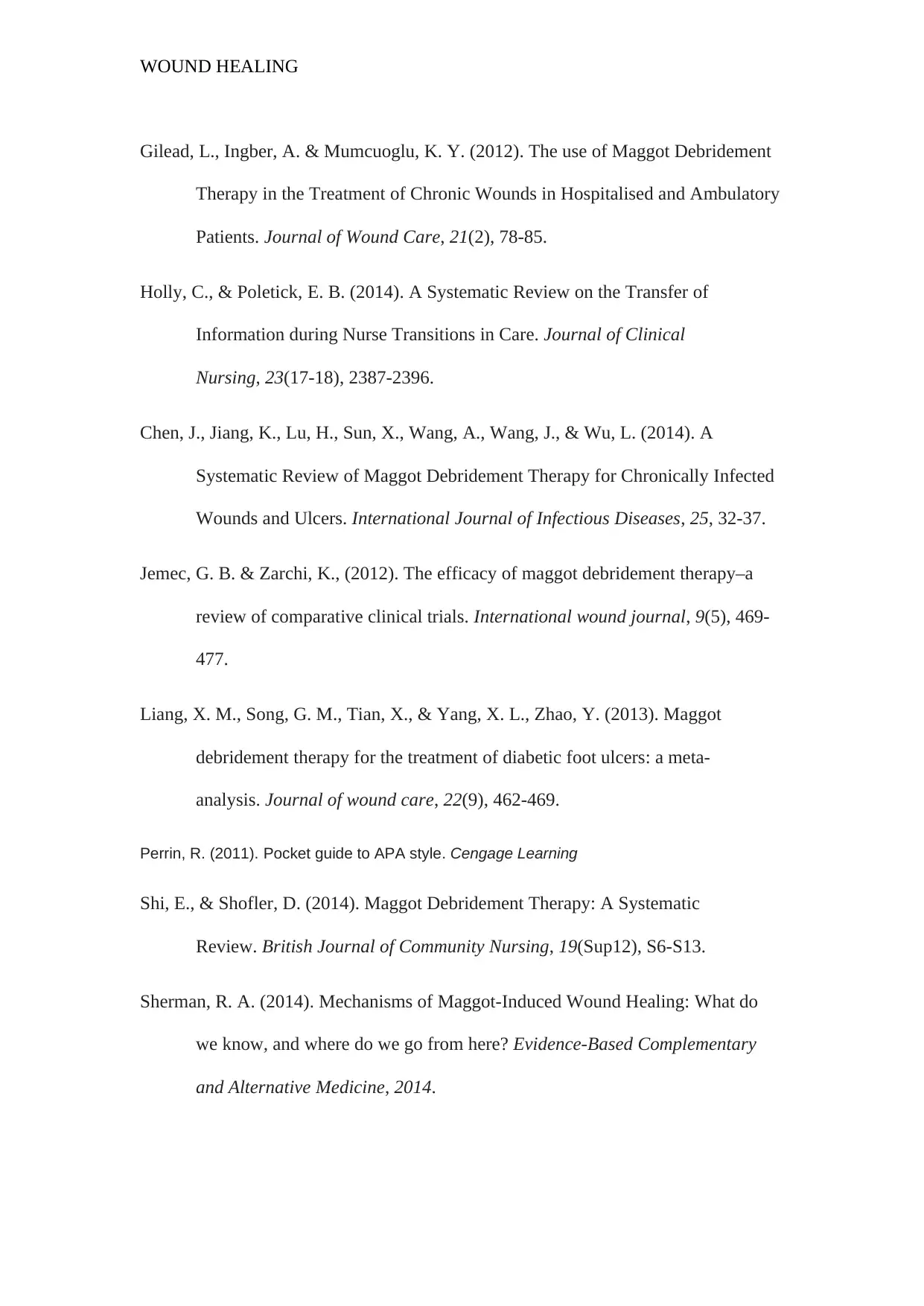
WOUND HEALING
Gilead, L., Ingber, A. & Mumcuoglu, K. Y. (2012). The use of Maggot Debridement
Therapy in the Treatment of Chronic Wounds in Hospitalised and Ambulatory
Patients. Journal of Wound Care, 21(2), 78-85.
Holly, C., & Poletick, E. B. (2014). A Systematic Review on the Transfer of
Information during Nurse Transitions in Care. Journal of Clinical
Nursing, 23(17-18), 2387-2396.
Chen, J., Jiang, K., Lu, H., Sun, X., Wang, A., Wang, J., & Wu, L. (2014). A
Systematic Review of Maggot Debridement Therapy for Chronically Infected
Wounds and Ulcers. International Journal of Infectious Diseases, 25, 32-37.
Jemec, G. B. & Zarchi, K., (2012). The efficacy of maggot debridement therapy–a
review of comparative clinical trials. International wound journal, 9(5), 469-
477.
Liang, X. M., Song, G. M., Tian, X., & Yang, X. L., Zhao, Y. (2013). Maggot
debridement therapy for the treatment of diabetic foot ulcers: a meta-
analysis. Journal of wound care, 22(9), 462-469.
Perrin, R. (2011). Pocket guide to APA style. Cengage Learning
Shi, E., & Shofler, D. (2014). Maggot Debridement Therapy: A Systematic
Review. British Journal of Community Nursing, 19(Sup12), S6-S13.
Sherman, R. A. (2014). Mechanisms of Maggot-Induced Wound Healing: What do
we know, and where do we go from here? Evidence-Based Complementary
and Alternative Medicine, 2014.
Gilead, L., Ingber, A. & Mumcuoglu, K. Y. (2012). The use of Maggot Debridement
Therapy in the Treatment of Chronic Wounds in Hospitalised and Ambulatory
Patients. Journal of Wound Care, 21(2), 78-85.
Holly, C., & Poletick, E. B. (2014). A Systematic Review on the Transfer of
Information during Nurse Transitions in Care. Journal of Clinical
Nursing, 23(17-18), 2387-2396.
Chen, J., Jiang, K., Lu, H., Sun, X., Wang, A., Wang, J., & Wu, L. (2014). A
Systematic Review of Maggot Debridement Therapy for Chronically Infected
Wounds and Ulcers. International Journal of Infectious Diseases, 25, 32-37.
Jemec, G. B. & Zarchi, K., (2012). The efficacy of maggot debridement therapy–a
review of comparative clinical trials. International wound journal, 9(5), 469-
477.
Liang, X. M., Song, G. M., Tian, X., & Yang, X. L., Zhao, Y. (2013). Maggot
debridement therapy for the treatment of diabetic foot ulcers: a meta-
analysis. Journal of wound care, 22(9), 462-469.
Perrin, R. (2011). Pocket guide to APA style. Cengage Learning
Shi, E., & Shofler, D. (2014). Maggot Debridement Therapy: A Systematic
Review. British Journal of Community Nursing, 19(Sup12), S6-S13.
Sherman, R. A. (2014). Mechanisms of Maggot-Induced Wound Healing: What do
we know, and where do we go from here? Evidence-Based Complementary
and Alternative Medicine, 2014.
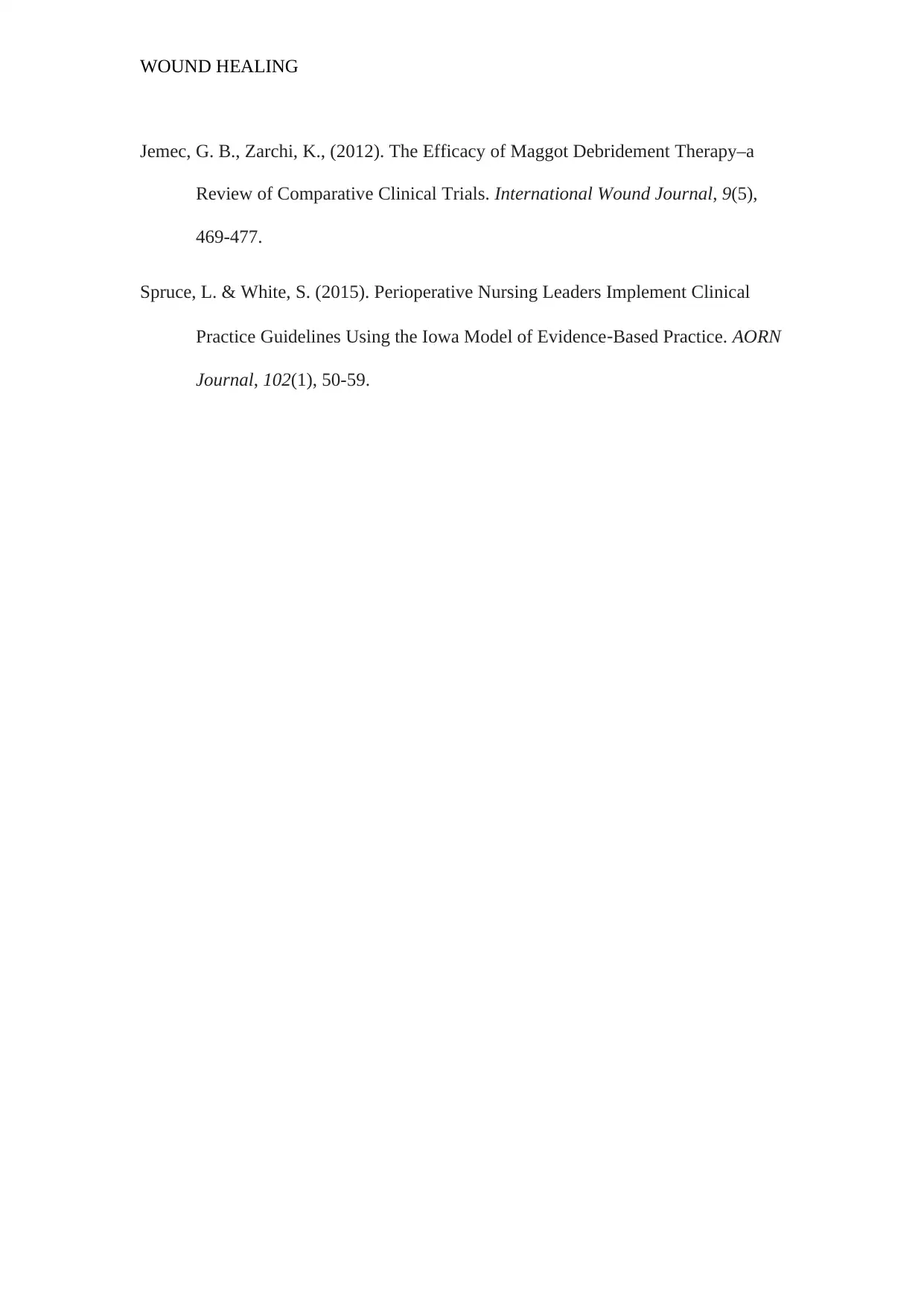
WOUND HEALING
Jemec, G. B., Zarchi, K., (2012). The Efficacy of Maggot Debridement Therapy–a
Review of Comparative Clinical Trials. International Wound Journal, 9(5),
469-477.
Spruce, L. & White, S. (2015). Perioperative Nursing Leaders Implement Clinical
Practice Guidelines Using the Iowa Model of Evidence‐Based Practice. AORN
Journal, 102(1), 50-59.
Jemec, G. B., Zarchi, K., (2012). The Efficacy of Maggot Debridement Therapy–a
Review of Comparative Clinical Trials. International Wound Journal, 9(5),
469-477.
Spruce, L. & White, S. (2015). Perioperative Nursing Leaders Implement Clinical
Practice Guidelines Using the Iowa Model of Evidence‐Based Practice. AORN
Journal, 102(1), 50-59.
1 out of 12
Related Documents
Your All-in-One AI-Powered Toolkit for Academic Success.
+13062052269
info@desklib.com
Available 24*7 on WhatsApp / Email
![[object Object]](/_next/static/media/star-bottom.7253800d.svg)
Unlock your academic potential
© 2024 | Zucol Services PVT LTD | All rights reserved.





